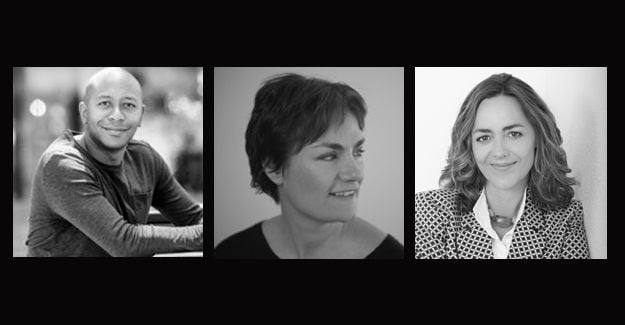#IMC2017: Creatives on effective storytelling

Abey Mokgatswane, CEO of Ogilvy SA, spoke of the dichotomy of brands becoming artificially intelligent while realising the need to going back to the legends we have always held as true. His session really popped as it was posted in full on the @OgilvyTalksSA Instagram feed to keep the Conference graveyard shift's attention, even if that shifted to social media.
He explained that before we can make sense of information, it’s already floating around in our brains, which is why storytelling is such an effective, emotive vehicle.
But some definitely do this whole storytelling thing better than others. As proof, Mokgatswane played a clip of Ogilvy alumni #Napsta explaining that we love stories because they enchant our world, they are catalysts of the imagination we are born with, and that black people are particularly good at using sound effects to really animate when telling a story - all the more reason for diversity in agencies.
Visuals: Ripe for disruption
Mokgatswane also spoke of digital disruption from the concept of singularity, where machines can think and create for themselves without human command. "Then there’s an innovation we haven’t factored in yet – the innovation of voice." While everything is about UX and how things look, Mokgatswane predicts we are fast nearing the time where all will be command-driven; where Siri and Alexa can get you what you want through voice commands alone. The impact of that will change the world fundamentally as we think visually first. Now even that is ripe for disruption.
How digital has further siloed creativity
Fran Luckin, CCO of Grey Africa, was next on an ‘adwoman’s adventures in integration'. She spoke of the power of the learning experience, which is when you hear a voice saying in your head: “You know that thing you just did? Don’t do it again.” Luckin showed us how the Coca-Cola Hilltop commercial from 1972 was reimagined through Project Re:brief, with a personalised 'thank you' message through special vending machines. The 'advertising experiment' from 2011 had Google partner with four global brands to show how the ideas that defined the advertising industry in its infancy can still inspire a new generation of creatives and marketers.
While that specific campaign was a success, Luckin also delved into why ad agencies might not be that relevant any more. To illustrate this, she spoke of the change in Cannes Lions' winners over the past two decades, which is very instructive. While Cannes Lions initially formed as a film-ad competition, print and outdoor were only introduced in 1992, with cyber added as a category in 1998, at the height of the Silicon Valley boom. It’s all about channels, said Luckin, with digital bleeding out into the other categories over the next few years as a sign that the digital revolution was "... a cultural shift and not a medium like radio and TV but a medium like air."
Luckin said the Titanium Lion award is the ultimate, for "great ads that don’t look like ads", nor do they necessarily fit into a specific category. Instead, agencies enter their work into the Integrated and Titanium categories and it’s only defined in the judging room each year.
Do we even know what constitutes integrated marketing communications?
On the growth of integrated marketing communications or IMC, Luckin said that as late as 2011, there was debate on the usefulness and definition thereof.
Luckin says it was a concept, not a process, so agencies didn’t respond well to its evolution. She spoke of legacy structures and ad agencies mimicking their clients’ industrial production lines. So, we simply added another silo or point at which the brief gets kicked, to “make it digital,” even going so far as to make the creative the custodian of the work. This is not the answer as you then have a group of people from a specialist discipline that are not fully integrated with the rest of the agency.
Luckin explained that’s where Grey London’s 'open culture' comes in: They repositioned managers as mentors and got rid of offices, reassigning individual control sign-off to the creative team responsible and aiming to get it 'at least 70% right' by planning for integration rather than glibly stating they work together, all in a move towards the future of work that's now being emulated across the globe.
Getting that creative tap to flow harmoniously
In the final talk of the pre-tea session we heard from Gillian Rightford, founder of Adtherapy. Rightford explained her world of work was built on the idea of challenges in the industry, particularly as she took the idea of the agency-client relationship forward. She spoke of the creative tap and whether it’s open or closed.
Rightford said many of those client-agency relationships are less than ideal, and that she is often described as a cross between a freedom fighter and an agony aunt. It’s a game of commercial creativity, where only the fittest survive. It's definitely worth working on as a good client-agency relationship can account for up to 37% better creative. She asks: "But do we really want better creative?" We’re probably exposed to 5,000 advertising messages a day, and of those, our subconscious gets rid of all but 76, with only 12 making an impact. We are unlikely to remember more than two of those the next day.
That said, creative advertising is more predictable in achieving its results and is less risky than advertising no-one notices and it's a good client-agency relationship that generates that output. Rightford's 'open creative tap' analogy then is about when you have the best brains working on your brief. That's not just something that happens when you’re sitting behind your desk.
When that tap is closed, through a complex and frustrating process of incessant reverts, abusive behaviour and miscommunication, Rightford says there are two main issues at play: a fear of loss of revenue that the work will go elsewhere; and actual loss of hope, as the exceptional creatives no longer want to work on that business.
Rightford played the following video, which illustrates how the client and agency see each other:
When the creative tap is closed and we don’t appreciate each other’s role, marketers feel the need to threaten to fire the agency, to escalate to the MD. The agency tends to feel frustrated at losing time, good people leave, they lose hours and money, do work they don’t think will work and only do safe work - a case of nobody winning.
To get that tap open, Rightford says we need to ensure we bring the right skills to the table, to think of the psychological tonality and do it right procedurally. The relationship is driven by approvals, mutual timings, briefs, respect and collaboration. It also helps to understand your purpose: "It’s as simple as reading the advertising Code of Conduct if that’s the industry you’re playing in," said Rightford.
In design-thinking, getting this right lies in seeing the process as one of co-creating rather than of buying and selling, which is where lots of the reverts and frustrations come in. That’s how to simplify and unlock value in identifying marketing as a commercial role. Remember that communication should be fun, says Rightford – Let creatives be more than just deliver on orders by making work that actually changes the world for the better. That's what I'd call a win-win.
Follow the #IMCConf hashtag for the latest updates!
































